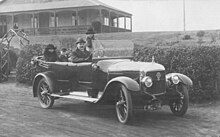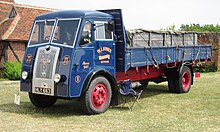Vulcan engine
The Vulcan Motor and Engineering Company Limited was a British manufacturer of automobiles and commercial vehicles from Southport , Lancashire . Founded in 1902, the company ran into financial difficulties in the 1920s and 1930s and was liquidated in 1936. The brand name and production facilities were transferred to Tilling Stevens . Production at the Maidstone site continued until 1953. In that year Tilling Stevens was taken over by the Rootes Group and the production of Vulcan vehicles was finally discontinued.
Company history
The company Vulcan Motor Manufacturing and Engineering Co Limited began in 1902 with the production of automobiles. In 1906 the company was renamed Vulcan Motor and Engineering Co Limited . The company produced small numbers of cars and trucks . In the 1920s, the company ran into financial difficulties that led to the cessation of car production. The problems continued into the 1930s, so that liquidation in 1936 could no longer be averted. The land and buildings went to J. Brockhouse , who owned a vehicle trailer manufacture. The brand name and production rights were acquired from Tilling Stevens . Tilling Stevens moved the production to Maidstone, the location of the company and continued production under the brand name Vulcan . A new truck model was to be presented at the 1939 Commercial Motor Show, which was canceled due to the outbreak of World War II. However, in 1941 the company received approval from the Ministry of Transport to build the type for civilian customers. In 1953 Tilling Stevens was taken over by the Rootes Group . Since there were already two commercial vehicle manufacturers in the group with Commer and Karrier , there was no need for another type series. The production of the truck developed by Vulcan was discontinued and the brand name was no longer used.
Passenger cars
| model | construction time | cylinder | Cubic capacity cm³ |
| 6 HP | 1903 | 1 | 628 |
| 10 HP | 1904 | 2 | 1431 |
| 10 HP | 1905 | 2 | 1526 |
| 12 HP | 1905 | 4th | 2212 |
| 18 HP | 1905 | 4th | 3053 |
| 10 HP | 1906-1909 | 2 | 1356 |
| 14 HP | 1906-1907 | 4th | 2799 |
| 18/20 HP | 1906-1910 | 4th | 3923 |
| 25/30 HP | 1906-1908 | 4th | 4680 |
| 30 HP | 1907-1910 | 6th | 4785 |
| 10/12 HP | 1908-1909 | 2 | 1961 |
| 20 HP | 1908-1910 | 4th | 3923 |
| 25 HP | 1908-1910 | 4th | 4398 |
| 35 HP | 1908-1910 | 6th | 5885 |
| 12 HP | 1909 | 4th | 2172 |
| 16 HP | 1909 | 4th | 3190 |
| 15.9 HP | 1911-1912 | 4th | 2413 |
| 23.8 HP | 1911 | 6th | 3620 |
| 10/12 HP | 1912 | 4th | 1944 |
| 19.6 HP | 1912 | 4th | 2489 |
| 25/30 HP | 1912 | 6th | 4479 |
| 10/15 HP | 1913-1914 | 4th | 2409 |
| 15/20 HP | 1913 | 4th | 3012 |
| 15.9 HP | 1914 | 4th | 3610 |
| 15/20 HP | 1914 | 4th | 3817 |
| 8 HP | 1915 | 4th | 1455 |
| 15 HP | 1915 | 4th | 2409 |
| 15/20 HP | 1915 | 4th | 2610 |
| 20/28 HP | 1915 | 4th | 3817 |
| 20/25 HP | 1919-1920 | 8th | 3500 |
| 12 HP | 1920-1924 | 4th | 1795 |
| 14 HP | 1920 | 4th | 2121 |
| 16 HP | 1920-1922 | 4th | 2614 |
| 20/50 HP | 1920 | 4th | 3686 |
| 9 HP | 1921-1922 | 2 | 1018 |
| 14 HP | 1921 | 4th | 2297 |
| 20 HP | 1921-1924 | 4th | 3686 |
| 10 HP | 1922-1923 | 2 | 1400 |
| 20 HP | 1922 | 4th | 3309 and 3562 |
| 12 HP | 1925 | 4th | 1496 |
| 14/40 HP | 1928 | 6th | 1696 |
| 16/60 HP | 1928 | 6th | 1990 |
A vehicle of this brand was on display at the Museum of Irish Transport in Killarney .
Trucks
The company produced a number of different types of trucks for payloads from 30 cwt to 5 tons in the 1910s and 1920s . Both conventional long- nosed vehicles and forward control vehicles were manufactured. The numbers remained low, not least because of the economic difficulties. At the time of the takeover by Tilling Stevens, trucks were produced for payloads of 2.5, 3 and 5 tons. These were front control vehicles that were offered with engines from different manufacturers. From 1932 an engine developed by Vulcan was also available. Special vehicles, such as garbage trucks and sweepers , were also built on the chassis . The truck chassis were also used to set up coaches and buses. As early as 1922, a bus structure with 22 seats was placed on the smallest chassis for 2 tons payload. In 1932 the Brisbane appeared with 32 seats. This bus got the engine developed by Vulcan with a displacement of 6.6 l . The largest bus was the Emperor , a double-decker bus that appeared in 1930 .
The 6VF was developed under the leadership of Tilling Stevens , a modern forward control vehicle for a 6 ton payload. The truck was offered with various gasoline and diesel engines . The hopes associated with the new model were initially dashed because the 1939 Commercial Motor Show, at which the vehicle was to be presented, was canceled due to the outbreak of war. Many companies in the British commercial vehicle industry were converted to the production of armaments. In 1941, however, the company succeeded in obtaining a production permit for the civilian market from the Ministry of Transport . The 6VF enjoyed great demand from UK freight forwarders as it was practically the only modern vehicle available. The vehicles produced during the war were powered by a four-cylinder engine with an output of 78 bhp . Because of the shortage of materials caused by the war, the vehicles were delivered with many differently designed radiator grills.
After the end of the war, the vehicle was initially produced unchanged, only the driver's cab was given a facelift . Since the Superpoise from Commer and the Bantam from Karrier have already produced vehicles of the corresponding size class in the corporate group, there was no need to continue production after the takeover by the Rootes Group . The last Vulcan truck was assembled in 1953, and the brand was later not used again by the Rootes Group companies.
literature
- Harald H. Linz, Halwart Schrader : The great automobile encyclopedia. BLV, Munich 1986, ISBN 3-405-12974-5
- GN Georgano : cars. Encyclopédie complète. 1885 à nos jours. Courtille, 1975 (French)
- David Culshaw, Peter Horrobin: The Complete Catalog of British Cars 1895-1975 . Veloce Publishing, Dorchester (1997), ISBN 1-874105-93-6 (English)
- SW Stevens-Strattan: British Lorries 1900–1902 . Ian Allan ltd, 1992, ISBN 0-7110-2091-4 (English)
Web links
- British Motor Manufacturers (1894–1960) ( Memento of February 5, 2012 in the Internet Archive ) (English)
Remarks
- ↑ According to Stevens-Stratten, it was not founded until 1904
- ↑ Stevens-Strachan gives both 1931 and 1936 for the takeover



